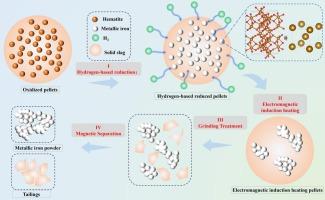高磷鲕粒经氢还原—电磁铁相重构—磁分离制备近零碳铁粉
IF 4.6
2区 工程技术
Q2 ENGINEERING, CHEMICAL
引用次数: 0
摘要
为了克服传统碳热还原的局限性,特别是其高碳足迹和对高磷鲕状铁矿石(HPOIO)中细分布铁矿物的低效处理,本研究引入了一种结合氢还原、电磁感应加热和磁选的创新工艺。在优化的还原条件下(950℃,90 min, 10 L/min H₂流量),氧化球团的金属化程度为85.56%。通过1350°C电磁感应加热30分钟,实现了深刻的显微组织转变,导致金属铁晶粒的平均等效圆直径增加了约16倍,从最初的1.19 μm增加到最终的19.03 μm。在再结晶和相重排的驱动下,这种微观结构的演变将细分散的铁相转化为粗大的蠕蠕状块状团聚体,显著改善了渣-金属分离。磁感应处理的有效性通过磁性精矿的大幅升级得到了证明。铁品位从最初的59.57%上升到91.18%,磷含量从0.26%下降到0.09%,脱磷效率从12.14%上升到79.77%。综合方法展示了一种可行的近零碳路线,通过氢基直接还原和精确控制的铁相重建,将HPOIO转化为高品位低磷铁粉。本文章由计算机程序翻译,如有差异,请以英文原文为准。

Near-zero carbon iron powder from high‑phosphorus oolitic pellets via hydrogen reduction-electromagnetic iron phase reconstruction - magnetic separation
To overcome the limitations of conventional carbothermic reduction—specifically its high carbon footprint and the inefficient treatment of finely disseminated iron minerals in high‑phosphorus oolitic iron ore (HPOIO)—this study introduces an innovative process combining hydrogen reduction, electromagnetic induction heating, and magnetic separation. Under optimized reduction conditions (950 °C, 90 min, 10 L/min H₂ flow), the oxidized pellets attained a metallization degree of 85.56 %. A profound microstructural transformation was achieved via electromagnetic induction heating at 1350 °C for 30 min, which resulted in an approximately 16-fold increase in the average equivalent circular diameter of the metallic iron grains, from an initial 1.19 μm to a final 19.03 μm. This microstructural evolution, driven by recrystallization and phase rearrangement, converted finely dispersed iron phases into coarse vermicular and massive aggregates, markedly improving slag–metal separation. The efficacy of the induction treatment was demonstrated by a substantial upgrade in the magnetic concentrate. This was evidenced by an elevation of the iron grade to 91.18 % from an initial 59.57 %, a concomitant drop in phosphorus content to 0.09 % from 0.26 %, and a resultant surge in dephosphorization efficiency to 79.77 % from 12.14 %. The integrated approach demonstrates a viable near-zero-carbon route for converting HPOIO into high-grade, low-phosphorus iron powder via hydrogen-based direct reduction and precisely controlled iron phase reconstruction.
求助全文
通过发布文献求助,成功后即可免费获取论文全文。
去求助
来源期刊

Powder Technology
工程技术-工程:化工
CiteScore
9.90
自引率
15.40%
发文量
1047
审稿时长
46 days
期刊介绍:
Powder Technology is an International Journal on the Science and Technology of Wet and Dry Particulate Systems. Powder Technology publishes papers on all aspects of the formation of particles and their characterisation and on the study of systems containing particulate solids. No limitation is imposed on the size of the particles, which may range from nanometre scale, as in pigments or aerosols, to that of mined or quarried materials. The following list of topics is not intended to be comprehensive, but rather to indicate typical subjects which fall within the scope of the journal's interests:
Formation and synthesis of particles by precipitation and other methods.
Modification of particles by agglomeration, coating, comminution and attrition.
Characterisation of the size, shape, surface area, pore structure and strength of particles and agglomerates (including the origins and effects of inter particle forces).
Packing, failure, flow and permeability of assemblies of particles.
Particle-particle interactions and suspension rheology.
Handling and processing operations such as slurry flow, fluidization, pneumatic conveying.
Interactions between particles and their environment, including delivery of particulate products to the body.
Applications of particle technology in production of pharmaceuticals, chemicals, foods, pigments, structural, and functional materials and in environmental and energy related matters.
For materials-oriented contributions we are looking for articles revealing the effect of particle/powder characteristics (size, morphology and composition, in that order) on material performance or functionality and, ideally, comparison to any industrial standard.
 求助内容:
求助内容: 应助结果提醒方式:
应助结果提醒方式:


